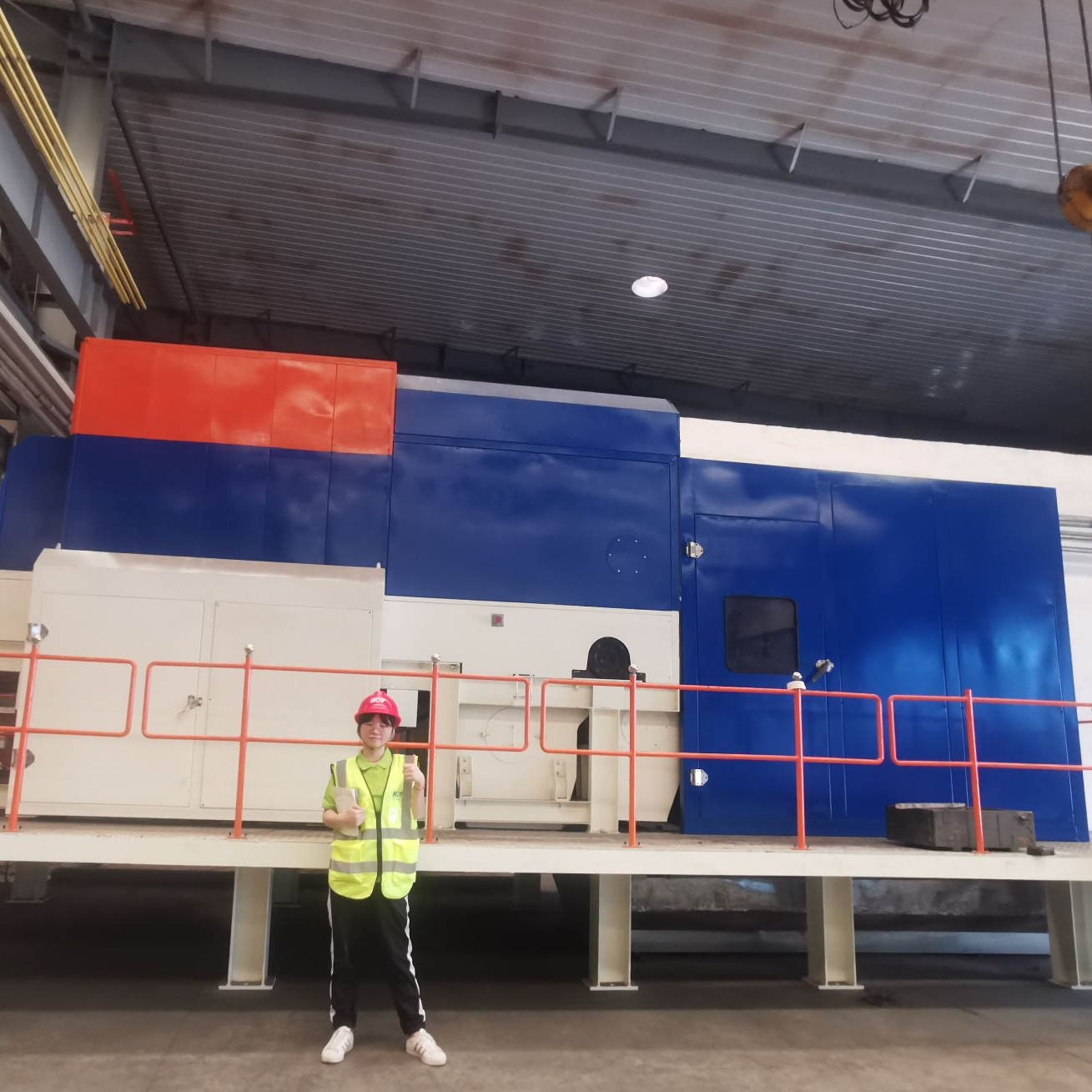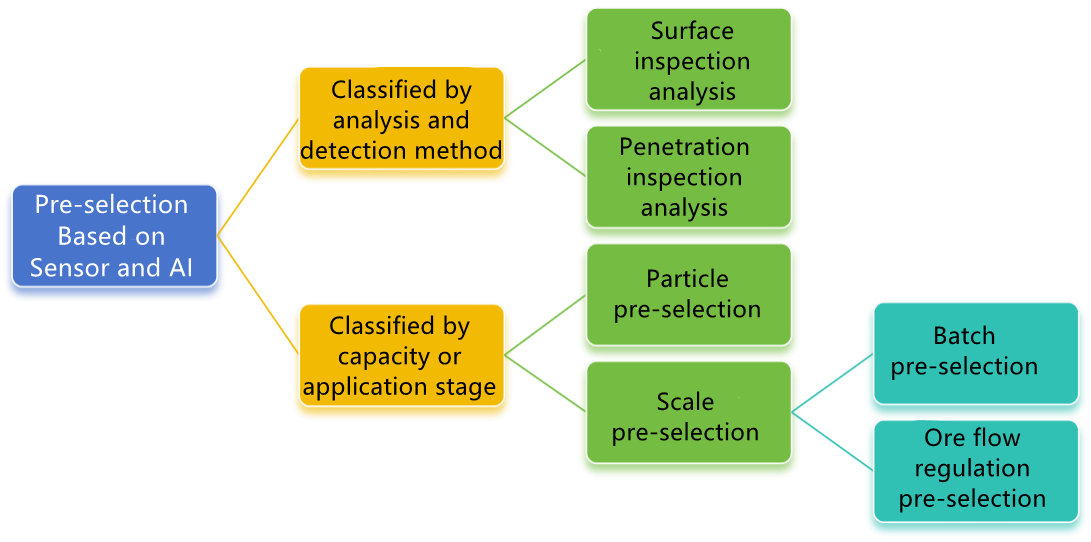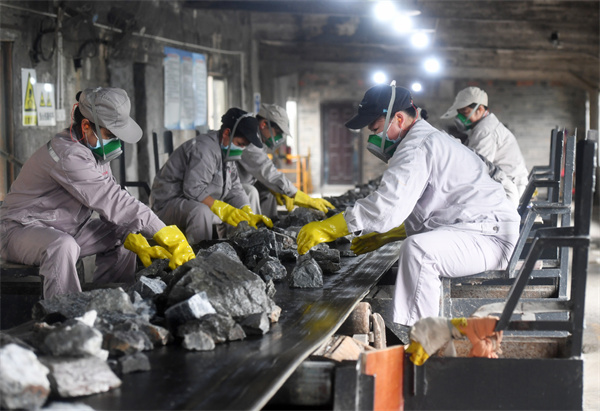
1. Introduction
In recent years, thanks to advancements in sensor and algorithm technologies, various innovative sorting processes have emerged, such as X-ray sorting, CCD color sorting, and nuclear magnetic resonance sorting. This article aims to provide a comprehensive overview of several sorting techniques, including heavy media Pre-Concentration (Sorting), X-ray Pre-Concentration (Sorting), CCD color sorting, and nuclear magnetic resonance Pre-Concentration (Sorting). It will also explore how manufacturing facilities can leverage these new technologies to prolong their technological and economic lifespan while maximizing efficiency. This discussion is particularly relevant in today's context, where the application of AI and intelligent transformations are becoming increasingly prominent.
Classification of Water-free Pre-Concentration (Sorting) Technologies Based on Sensor and Algorithm Integration:
From a technical standpoint, these technologies can be categorized into surface inspection analysis and penetration inspection analysis.
Pre-Concentration (Sorting) capacity or application stages can be further divided into particle Pre-Concentration (Sorting) and scale Pre-Concentration (Sorting). Among these, particle Pre-Concentration (Sorting) and scale Pre-Concentration (Sorting) can be further subdivided based on the specific sorting methods, including batch Pre-Concentration (Sorting) and ore flow regulation Pre-Concentration (Sorting).

Classification of Water-free Pre-Concentration (Sorting) Technologies Based on Sensor and Algorithm Integration
2. The Value of Pre-tailing and Pre-Concentration (Sorting) Methods Based on Ore Properties
2.1 The Value of Pre-tailing
The mining industry accounts for 2% to 3% of global energy consumption, which is equivalent to the energy consumed by the entire aviation industry.
During their design, construction, start-up, and production phases, large-scale mining operations need to consider energy efficiency and reduction in energy consumption. This may involve adopting new technologies and equipment from the outset or energy-saving modifications during production. Regarding energy consumption, ore beneficiation processes have relatively high energy consumption, with most energy usage occurring in the grinding and selection stages of ore processing. Specifically, ball mills consume a significant portion of the electricity used in a processing plant due to their high installed power, high productivity, and substantial load. Additionally, the materials and labor involved in the grinding, separation, and tailings disposal processes constitute a significant portion of the production cost for processing plants.
Therefore, reducing the costs associated with the grinding and selection stages for processing plants is critical to improving overall efficiency. The concept of "more crushing and less grinding, early rejection" is a consensus reached by many professionals and experts. "More crushing and less grinding" is based on Bond's comminution the ore, which aims to generate more fractures in the low-energy crushing stage, thereby reducing energy consumption per grinding unit. "Early rejection" refers to separating waste rocks and low-grade ore from the feed material before it enters the ball mill, thereby reducing the mill's feed rate..
Regarding the former, there have been numerous application and modification cases over the years. These include using new crushing equipment, increasing the number of crushing stages, and reducing the feed particle size. As for the latter, early rejection has primarily been applied in magnetite ore production, where equipment like magnetic pulleys and dry magnetic separators are used to separate waste rocks and gangue based on their magnetic differences. In cases such as scheelite ore, where valuable minerals have a significant visual difference from the gangue, manual sorting is employed to upgrade the ore grade before it enters the grinding process.
Various methods exist to separate valuable minerals and gangue without significant magnetic differences or visual distinctions. These include heavy media separation based on density differences and electrostatic separation, which utilizes differences in the electrical charging properties of different minerals in an electric field.
2.2 Some Pre-Concentration (Sorting) Methods Based on Ore Properties
Manual Sorting
Manual sorting is an ancient method with historical examples such as Egyptians manually separating gold nuggets from gravel and Greeks and Romans using manual sorting to classify ores before smelting. This method has been historically employed in mineral sorting, and it is still used in various contexts, such as tungsten ore sorting, coal gangue sorting, and quartz rock sorting.
Characteristics of manual sorting include low initial investment and slow conveyor belt transportation with personnel on both sides for sorting, making it suitable for production. However, it has high labor costs because individual workers' productivity is limited, often requiring a large workforce, resulting in increased labor costs. Additionally, manual sorting has low production efficiency, as repetitive mechanical labor over extended periods can lead to worker fatigue, resulting in decreased production efficiency. The sorting accuracy could be better, relying on the experience of workers and fluctuations in their condition, which can lead to reduced product quality. In some sorting contexts, sorting accuracy can even drop to 60%.

Dry Magnetic Separation
Dry magnetic separation is primarily used to pre-select and enrich minerals with strong magnetic properties, such as magnetite ore. This method is widely employed in large-scale magnetite ore processing plants. Depending on the particle size of separation, it can be categorized into coarse dry magnetic separation, fine dry magnetic separation, and ultrafine dry magnetic separation.
Dense Media Separation
Dense media Pre-Concentration (Sorting) is a mineral processing technique that relies on differences in mineral density for separation. It involves suspending minerals in a rich media suspension with a density adjusted to be between the densities of the minerals to be separated. As a result, heavy minerals sink while light minerals float. The separated minerals are then recovered by draining the suspension and cleaning the rich media from the minerals. This process is typically used as a preliminary step before further processing of minerals.
This method can accurately and efficiently separate minerals, even when their densities are similar. It can also be used to process minerals that are difficult to separate using other methods. Additionally, dense media separation can be easily adjusted to accommodate changes in feed material and production requirements.
However, dense media separation also has some drawbacks. It requires significant water and rich media, which can be costly and environmentally impactful. The process may also need a large workforce and specialized equipment, which can increase operational costs.
Typical equipment used in heavy media separation includes jigs, heavy media cyclones, and media recovery magnetic separators. Jigs are often utilized for coarse-grained materials, while heavy media cyclones are used for fine-grained materials. Magnetic separators are used to recover magnetic media from the dense media suspension.
Dense media separation is an effective mineral processing technique in the mining industry. However, its advantages and disadvantages should be carefully considered before deciding whether to use it in a specific application.
3. Overview of Pre-Concentration (Sorting) Technologies Based on Sensors and Algorithms
3.1 XRT Pre-Concentration (Sorting)
XRT (X-ray transmission) Pre-Concentration (Sorting) technology is an efficient mineral sorting technique widely applicable in mineral processing. The principle behind XRT sorting is to utilize the differential X-ray transmission within materials to separate ores with varying densities and compositions. XRT technology scans the ore with X-rays, measuring the transparency at different locations, and then sorts based on the differences in openness. This technology offers high sorting efficiency, low energy consumption, and environmental friendliness. In mineral sorting, XRT technology effectively enhances ore grade recovery rates, reduces production costs, and improves economic benefits. XRT technology has found extensive applications in fields like iron ore, manganese ore, tungsten ore, and tin ore and has become a significant technology in mineral sorting.
Advantages of XRT Technology:
1. High Sorting Efficiency: XRT technology can rapidly and accurately sort ores, significantly improving sorting efficiency.
2. Low Energy Consumption: Compared to traditional sorting methods, XRT technology has lower energy consumption, saving energy costs.
3. Environmentally Friendly: XRT technology typically does not produce significant emissions (usually equipped with dust collection devices for dust removal), meeting environmental requirements.
(Due to character limits, please click here to read more.)